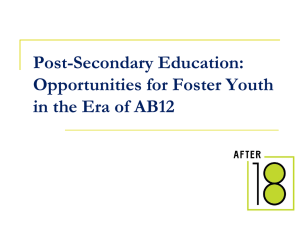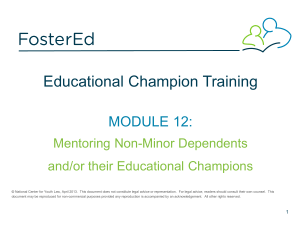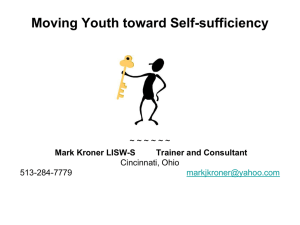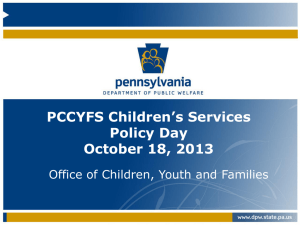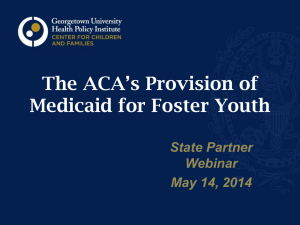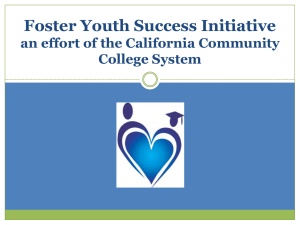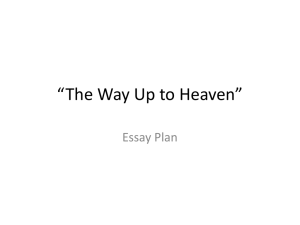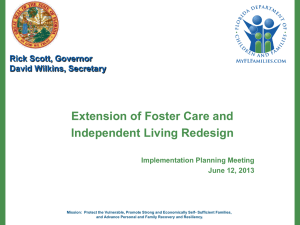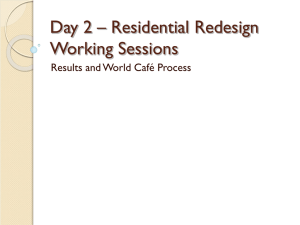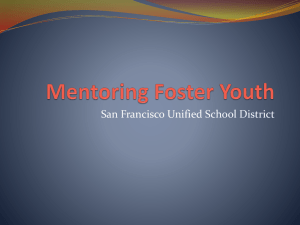Supporting Success in the Era of AB12
advertisement
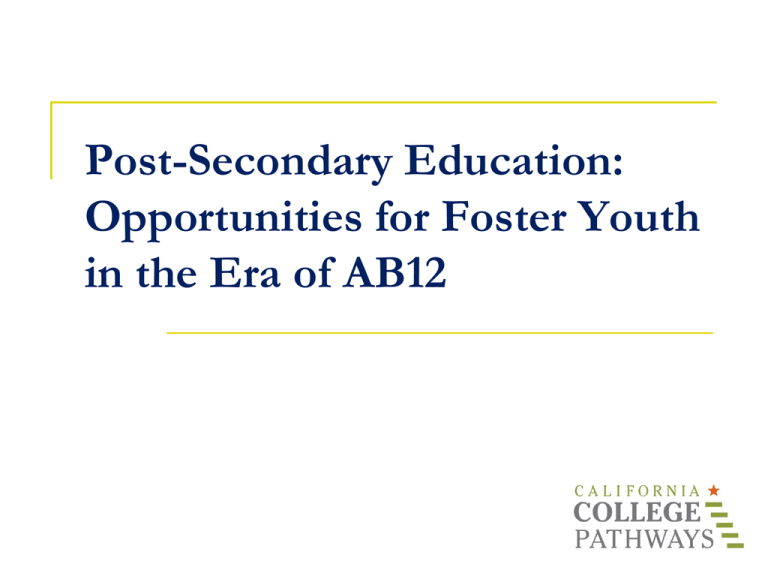
Post-Secondary Education: Opportunities for Foster Youth in the Era of AB12 Agenda Introductions AB12 – A New Opportunity How to Motivate and Inspire - Break College – The Basics System Overview Admission and Enrollment Financial Aid Retention and Support Programs Questions and Answers Introductions AB12 – A New Opportunity Foster Youth and Education Last year in California over 4600 foster youth aged out of care Of youth surveyed regarding AB12, 83% indicated a desire to go to college Studies show that only 25% will complete one year of college and 5% will obtain a 2 or 4 year degree Why Education Matters: It Pays Why Else Higher Education Matters Changing job market increasing importance of higher education Lower incarceration rates Improved health outcomes lower smoking rates more positive perceptions of personal health Higher levels of civic participation, including volunteer work and voting What challenges do foster youth currently face in higher education? Inadequate housing Lack of financial resources Frequent changes in home and school leave youth unprepared Lack of adult role models Lack of information about higher education, financial aid, support resources etc. AB 12 Will Address Many of These Issues by Providing…. Housing through an approved placement In some cases may receive benefit directly Monthly visits with social worker and assistance with transition to independence Health insurance until age 21 Independent Living Services Potential of Extended Foster Care to Promote Educational Outcomes “Midwest Study” - Surveyed 732 youth who exited foster care from Iowa, Illinois, Wisconsin at ages 18, 19, 21, and 24 In care youth 3 times more likely to complete one year of college and 2.5 times more likely to obtain BA Being in care was associated with a 38 percent reduction in the risk of becoming pregnant AB12 will improve outcomes, but foster youth still likely to lag behind peers Need additional support – from you! In the past… Child Welfare Post-Secondary Education Foster Youth Moving Forward… Child Welfare Post-Secondary Education Foster Youth Encouraging Education Participation: An Evidence Based Approach Encourage youth who think they can’t go to college “No one rises to low expectations” Danger of the self-fulfilling prophecy Set high expectations – regardless of past performance Emphasize opportunity that extended foster care presents Consistently express expectation that the youth will graduate from high school and go on to college Encourage all adults involved with the student, including teachers, to give this message and to use such phrases as, “When you go to college….” Early Preparation “The intervention of one significant person at a critical point in the life of a student is extremely significant to educational success for students from low-income backgrounds.” – Joan Merdinger, PhD, Education Expert Motivate from a young age Team effort (social worker, caregiver, CASA, etc.) Bring in resources early County educational liaisons School counselors Foster Youth Services ILP A-G requirements and standardized tests Explain differences between college and high school Students choose to be there Flexible schedule – students manage their own time Breaks between classes Students get to pick their own classes Much wider range of subjects Career and technical education pathways Opportunities for extra-curricular activities Discuss the Benefits $$$ MORE MONEY $$$ More career options Chance to explore new fields Opportunities to develop communication skills, social interaction skills, analytical skills, and reasoning skills Make new friends and meet valuable connections Long term improved health Expose youth to role models and college life Connect with foster care alumni in college or who have completed postsecondary education Enroll in mentoring programs Field trips to local colleges Influence of peers Other ideas? Hold youth accountable “My junior year I only went to class about half the time. Then in my senior year, my first period teacher asked me to promise that I’d show up at least for first period every day. I ended up with the best attendance record in the whole class” – Former foster youth Hold high academic aspirations Set clear expectations Ask every month about school and grades Follow up on tasks related to education Use texting for reminders Accountability as expression of care Be authentic Career assessments and interest inventories Allow youth to assess what career fields might suit them best Broaden thinking about career options Recognize previously unknown skills and interests Create linkage between career choice and educational attainment Fun! Scenario Lisa is 18 years old and is nearing completion of high school. She doesn’t have very good grades although she will manage to graduate. Lisa is intelligent and primarily hasn’t excelled in school due to several changes in schools over the years and an overall lack of motivation. She has struggled socially and has expressed in the past that she hates sitting in a classroom all day long. She lives with her aunt and has decided to stay in foster care for the time being. The aunt wants to support Lisa to go to college, but she herself didn’t go to college and doesn’t know quite where to start. Lisa has two younger siblings who look up to her. Discussion Questions How would you approach a conversation with Lisa about her plans after high school? What are some strategies you might use to encourage her to participate in postsecondary education? How would you respond if she believed she couldn’t succeed in college? Who else might you bring in to assist with this process? College – The Basics Licensing Requirements The caregiver shall assist a nonminor dependent with developing the skills necessary for selfsufficiency including educational and career development.* A nonminor dependent may request assistance from the caregiver with the steps to attending college including application, enrollment, financial aid, and connecting to support resources. *Title 22, Division 6, Chapter 9.5, Section 893178(c)(6) Overview of Post-Secondary Education Systems Community college Career & Technical Education Private colleges CSU UC Community College Serves greatest number of foster youth of all three systems (estimated 7,000 - 10,000) 112 Colleges throughout state High school diploma 2-year Associate (AA) degree Transfer to 4-year university Career and technical education California State University 4-year institutions 23 campuses, 412,000 students More stringent admissions than community college and less than UC Accepts freshman admissions and transfer from community college 1200 – 1300 foster youth University of California 4-year institutions More stringent admissions requirements than CSU 10 campuses with 222,000 students Accepts freshman admissions and transfer from community college Career & Technical Education Career & Technical Education Options Regional Occupational Centers and Programs (ROCPs) Non-profit community based programs Community colleges Adult schools Private schools Career & Technical EducationConsiderations Targeted, career-focused training Can be shorter term programs Degree vs. Certificate Career Advancement Academies Financial aid is available Cost considerations and risks associated with private CTE schools Access – Admission and Enrollment Community Colleges - Admissions Eligibility for enrollment Online application – www.cccapply.org Getting transcripts Board of Governors fee waiver Community Colleges – Admissions & Assessment Assessment-COMPASS Evaluation Online ID Checking e-mail Benefits of self-identifying as foster youth Applying for EOPS Community Colleges – Enrollment Determining what classes to take – academic plans How to enroll Deadlines - importance of early enrollment and priority enrollment Payment of fees Dropping classes – impact and timelines Cal State – Freshman Admissions A-G requirements Grades and test scores CSU local preference Online application: www.csumentor.edu Application Deadline: Oct 1 – Nov 30 EOP application Application fee waiver Writing and math assessment UC Freshman Admissions A-G requirements Grades and test scores Personal statement Online application: www.universityofcalifornia.edu/apply Application Deadline: Nov 1 – Nov 30 Application fee waiver Writing requirement EOP application Cal State and UC – Transfer from Community College Students should plan for transfer as soon as they enter community college Academic counselor can help create plan 60 semester units college credit required plus specific course requirements Minimum 2.0 GPA for Cal State and 2.4 GPA for UC Financial Aid Costs of Attending College Community College CSU UC Private Fees/tuition $864 $6,489 $13,200 $30,144 Books and Supplies $1,656 $1,652 $1,500 $1,455 Miscellaneous $4,059 $4,041 $4,200 $3,812 Room & board (on campus) $7,800 $10,607 $13,200 $9,330 Room & board (off campus) $10,863 $11,379 $9,500 $9,330 Room & board (living w/ caregiver) $4,347 $4,253 $4,400 $3,880 Total $11K - $17K $16K – $23K $23K – $28K $40K – $45K Financial Aid Overview Cal-Grant Chafee Federal Grants Scholarships Work Study Loans BOG fee waiver Financial Aid The FAFSA - www.fafsa.gov How to get help completing the FAFSA Applying for BOG fee waiver Deadlines – apply early when possible March 2 for maximum aid CCC: Prior to start of term – sooner the better! Communication Impact of AB12 income on financial aid Applying for Aid Independent vs. dependent status Question #52: At any time since you turned age 13, were both your parents deceased, were you in foster care or were you a dependent or ward of the court? Question #59: As determined by a court in your state of legal residence, are you or were you in legal guardianship? Getting and keeping aid Enrollment requirements GPA requirements Chafee Grants Requirements Open dependency case or ward after 16th birthday Under 22 as of July 1 of the year they are applying Up to $5000 for college or vocational school To apply: FAFSA + Chafee application Award priority system Enrollment requirements Jeopardy! Name the 3 different public post-secondary education systems in California How does someone apply to enter community college? At what point should a student in community college start planning for transfer to a four year institution? What advantage do foster youth have when registering for classes that others do not? Jeopardy! What does the term “A-G classes” mean? What form needs to be completed to apply for federal financial aid? How does a foster youth apply for a tuition fee waiver? Name two people who a foster youth can contact about financial aid questions. College Retention The TILP and Higher Education Incorporate specific goals related to higher ed into the TILP Researching colleges College visits, meeting with peers and mentors Meet with FYSI liaison Applying for financial aid Obtaining transcripts Connecting to support resources Coordinate TILP activities with other support resources What you can do to help young adults stay in school Connect to campus based resources Ensure basic needs met – housing Collaborate with other adults in the youth’s life Identify local resources Connect with local college personnel Staying in School (cont.) Motivate and hold accountable Regular check-ins Ask for mid-term grades Text with reminders Follow up after key deadlines Be a support Provide practical information Provide an outlet Support Resources for Foster Youth FYSI EOP/EOPS Disabled Students Programs and Services Comprehensive Campus Support Programs Foster Youth Support Programs Comprehensive campus support programs Offer supportive services, both academic and nonacademic Located on CC, CSUs and UCs Continuum of programs: Visit www.cacollegepathways.org to locate Foster Youth Success Initiative (FYSI) Liaisons located at each community college Assist with navigating all academic and student support services and programs and accessing financial aid EOP/EOPS Essential program for lowincome, educationally challenged students Provides wide range of assistance, including book vouchers, child care referrals, etc. Program staff can be valuable liaison and are often knowledgeable about foster care Campus Services Disabled Students Programs and Services 20% of foster youth have a learning disability Provides support services, specialized instruction, and educational accommodations Other Services Student Education Plan Tutoring programs Resources for parenting youth Financial Aid Officers Career and Transfer Centers College/career success courses Wrap up and Next Steps Additional questions Implementation ideas Evaluation Contact Information For More Information: www.cacollegepathways.org Debbie Raucher debbie@johnburtonfoundation.org
